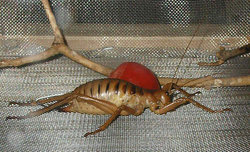Weta
|
|
Template:Dablink The Weta family comprises over one hundred (generally) large insect species endemic to the New Zealand archipelago. Their name comes from the Maori language, but has acclimatised itself in New Zealand English, so the plural "wetas" may appear. Their physical appearance is that of a cross between a cockroach and a cricket with the addition of large legs.

Weta can be found in environments ranging from mountainous conditions to urban gardens by virtue of their ability to cope with wide variations in temperature. They are nocturnal and flightless, with a diet consisting of leaves, other insects, fungi, dead animals and fruit.
About a tenth of the species of Weta belong to the Giant Weta species, most of which are generally significantly larger than other Wetas, despite already being large by insect standards. A Giant Weta can have a body length in excess of 8 cm not inclusive of its lengthy legs and antennae, and weigh more than 70 grams, making it both one of the largest insects in the world and heavier than a sparrow. Giant Weta tend to be less social and more passive than 'standard' Wetas. Giant Weta are classified in the genus Deinacrida, which is Greek for terrible grasshopper.
The sixty species of Cave Weta have extra-long antennae, longer legs, a passive demeanour, deafness and quietness. Cave Weta may be active within the confines of their caves during the daytime. Cave Weta are classified in the genus Gymnoplectron.
Giant Weta, along with the Tree, Ground and Tusked Weta, are members of the family Anostostomatidae (or Stenopelmatidae). Cave Weta are members of the family Rhaphidophoridae.
Many species of Weta are rare and endangered. Giant Weta are found primarily on small islands off the coast of the main islands. One recently-discovered species is only known to exist in a single location. Introduced pests and habitat destruction have all contributed to their decline. They have existed largely unchanged from the Mesozoic era until modern times, probably a result of the absence of native predators. In this respect, they could be compared with the ancient tuatara. Their place in the food chain is comparable with that held by mice and other rodents elsewhere in the world. Notably, like their foreign mouse equivalents, they also are hunted by the native owl: the Morepork.
In the absence of any land snakes in New Zealand, Weta have come to represent, for New Zealanders, the revulsion at things that creep and crawl in the dark: thus their place in folklore seems secure.
While Weta do not pose a risk of stinging or biting people, they are able to inflict painful scratches with the potential of dangerous infection. They are known to arc their hind legs into the air in warning to foes.
References
- Johns, P. M. (1997). "The Gondwanaland weta: family Anostostomatidae (formerly in Stenopelmatidae, Henicidae or Mimnermidae): nomenclatural problems, world checklist, new genera and species". Journal of Orthoptera Research 6: 125-138.da:Weta
